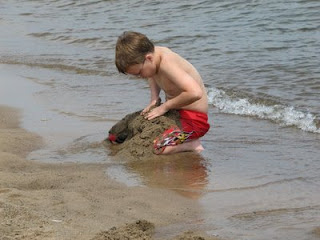 If you’re a regular visitor to Great Lakes beaches, you likely noticed that this year’s swim season was chillier than normal. Cold enough, in fact, that many chose to skip swimming in favor of other beach activities. And according to officials at the National Weather Service, this may explain the unusually low number of current-related fatalities and rescues this year.
If you’re a regular visitor to Great Lakes beaches, you likely noticed that this year’s swim season was chillier than normal. Cold enough, in fact, that many chose to skip swimming in favor of other beach activities. And according to officials at the National Weather Service, this may explain the unusually low number of current-related fatalities and rescues this year.
There were 6 fatalities and 12 rescues related to currents on the Great Lakes, which is below the 12-year average of 12 fatalities and 25 rescues per year.
As is typical, the majority of the 2014 incidents occurred along Lake Michigan. On average from 2002-2014, Lake Michigan had 25 incidents per year, while Lake Erie had 5 incidents per year, Lake Superior had 3 incidents and Huron and Ontario average 1 to 1.5 per year, respectively.
The data for 2014 has now been updated in the Great Lakes Current Incident Database, available at DangerousCurrents.org. The database was developed and is maintained by Michigan Sea Grant and National Weather Service (NWS). Megan Dodson, a NWS meteorologist, gathers the statistics for the database and provides yearly swim season assessments of conditions related to currents.
Dodson noted the cool weather influenced not just the below-average number of incidents, but where they happened too.
“A majority of the current-related incidents in 2014 occurred near river mouths, which is unusual when compared with past years,” she said. “The cooler air and water temperatures may have driven beachgoers to swim near river mouths and other outlets, where the water is much warmer. However, there are currents present that can be strong and vary depending on the flow of the outlet and the waves at the beach. While these currents are most dangerous during times of high waves, they can still be strong despite calmer lake conditions — as we saw during the 2014 swim season.” Read more
Swim season may be over, but it is never too early to start planning for next year. To stay safe in the water, be sure to:
- Steer clear of the pier — Nearly 60 percent of fatalities and rescues in the Great Lakes database occurred near breakwaters and piers. Structural currents are nearly always present near these barriers, even when waves are low. Breaking waves can also bounce off the structure, making swimming nearly impossible.
- Stay dry when waves are high — Nearly 85 percent of fatalities and rescues in the Great Lakes database happened when waves are 3-5 feet or greater. Unlike in the oceans, Great Lakes waves crash against the shoreline in rapid succession, making it difficult to swim. Additionally, strong rip currents are more likely when waves are above 3 feet. The combination of quickly approaching waves and strong currents create extremely dangerous conditions for swimmers.
- Don’t swim in the outlet — Water flowing from a river mouth or other outlet can push swimmers out into the lake. Nearly 40 percent of the 2014 incidents were outlet-current related.
For more information and safety tips, visit dangerouscurrents.org.

